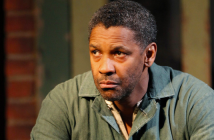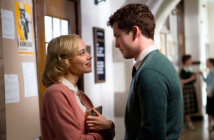
Editor’s Note: Doctor Strange is currently playing in wide theatrical release.
Anyone in the “Marvel Studios can do no wrong” (Agents of S.H.I.E.L.D. excepted) camp will find additional vindication in Marvel’s latest big-screen, superhero-themed comic-book adaptation, Doctor Strange. Before the Disney/Marvel marketing department began their multimedia onslaught early this year, casual superhero fans probably didn’t know who Doctor Stephen Strange was, what he did, and how he fit into the larger Marvel Cinematic Universe (MCU). Writer-director Scott Derrickson (Deliver Us From Evil, Sinister, The Day the Earth Stood Still, The Exorcism of Emily Rose) answers those questions and more, delivering one of the most visually inventive, cinematically engaging entries in not just the MCU, but out of it as well. Apparently, Marvel gave Derrickson free reign to pick and choose visual and narrative ideas from Doctor Strange’s five-decade long run in Marvel Comics and take them as far as their imaginations – not to mention a hefty effects budget – would allow. That Doctor Strange offers little, if anything, original on the character or story side is secondary. The overabundance of innovative, inventive, mind-bending visuals more than make up for the shortage of imagination elsewhere.
From the first, energetically directed, expectation-subverting set piece, to the last, humor-filled, action-free climax, Doctor Strange never ceases to surprise, engage, and entertain.
When we first meet Doctor Stephen Strange (Benedict Cumberbatch), he’s vying for the Mr. Hubris award, an award owned by Tony Stark (Robert Downey Jr.) on more than one occasion. He’s a brilliant, Manhattan-based neurosurgeon. He doesn’t have a problem reminding everyone around him, including ER doctor and ex-girlfriend, Christine Palmer (Rachel McAdams), about his brilliance or uniqueness (creator Steve Ditko has long been famous – or rather infamous – for his hardcore Randian beliefs). Except Stephen Strange is right: He’s the best of the best, a legend not just in his own mind, but everyone else’s. He undoubtedly suffers from a God Complex, but he also saves lives that other neurosurgeons couldn’t. A lifetime of success, however, has left Strange with the belief that he’s immune from physical harm too. As he soon learns after a careless car incident on a winding, nighttime road leaves him seriously wounded, his hands maimed beyond repair, he’s not. His arrogance unchanged, Strange undergoes seven surgeries, each one riskier and more experimental than the last, but the results remain the same. He still holds the title of “doctor,” but he’ll never be a neurosurgeon, brilliant or otherwise, again.
 Left without any viable alternatives, Strange heads east, east for Kathmandu, Nepal and a secret community of mystical monks, Kamar-Taj (a Shangri-La retreat in the comics, a seemingly normal monastery in the heart of Kathmandu in the film). He doesn’t have to climb any mountains or suffer cold and potential frostbite, but when he finds Kamar-Taj, it’s both a physical location and a state of mind, with the Ancient One (Tilda Swinton), as the wise master, mentor, and the Sorcerer Supreme. Strange enters the order of mystical warriors and monks as a mere apprentice, but he proves a quick, adept study, using his eidetic memory to memorize countless fighting spells. Simple spells can create energy-based shields and weapons; more complex spells can create space-shrinking portals and reverse the flow of time. Shields and weapons spark and sizzle with color-coded energy (mostly orange-yellow, occasionally green). Astral projections can take a mystical arts practitioner on a head-trip through space, time, and the spaces between.
Left without any viable alternatives, Strange heads east, east for Kathmandu, Nepal and a secret community of mystical monks, Kamar-Taj (a Shangri-La retreat in the comics, a seemingly normal monastery in the heart of Kathmandu in the film). He doesn’t have to climb any mountains or suffer cold and potential frostbite, but when he finds Kamar-Taj, it’s both a physical location and a state of mind, with the Ancient One (Tilda Swinton), as the wise master, mentor, and the Sorcerer Supreme. Strange enters the order of mystical warriors and monks as a mere apprentice, but he proves a quick, adept study, using his eidetic memory to memorize countless fighting spells. Simple spells can create energy-based shields and weapons; more complex spells can create space-shrinking portals and reverse the flow of time. Shields and weapons spark and sizzle with color-coded energy (mostly orange-yellow, occasionally green). Astral projections can take a mystical arts practitioner on a head-trip through space, time, and the spaces between.
But where Doctor Strange fails on a narrative level – and it’s hardly a failure, just a collection of superhero genre tropes and conventions – it succeeds beyond anyone’s wildest imaginations on a visual one.
Strange’s struggle to overcome his outsize ego and embrace his inner mystical warrior forms the crux or spine of his overly familiar journey, a hero’s journey (or rather a “Hero’s Journey”) we’ve seen countless times before, from Arrogance to Redemption, with an intermediate Fall from Grace, Setbacks, Failures, and Triumphs large and small. The Ancient One functions as a Morpheus-like sage and wisdom teacher, imparting all-important truths about the nature of reality and Strange’s role in that new, multi-level, multi-versal reality. Like too many of its predecessors in the MCU, the villain, Kaecilius (Mads Mikkelsen), a former pupil turned rogue, barely makes an impression. Derrickson barely gives Kaecilius significant screen time and when he does appear on screen, it’s usually to rumble, break a few priceless, magical artifacts, and generally make a nuisance of himself while he tries to lure Strange over to the dark side and the so-called “Dark Dimension.” (There’s a Mirror Dimension too, but the less said, the better).
But where Doctor Strange fails on a narrative level – and it’s hardly a failure, just a collection of superhero genre tropes and conventions – it succeeds beyond anyone’s wildest imaginations (except, of course, Derrickson and his collaborators behind the camera) on a visual one. From the first, energetically directed, expectation-subverting set piece that takes Inception’s folding building idea to its logical extreme, to the last, humor-filled, action-free climax that swaps out Strange’s mastery of the mystical arts with big-brain cleverness and all points in between, Doctor Strange never ceases to surprise, engage, and entertain. That Strange’s spiritual and emotional transformation feels equal parts perfunctory and obligatory, made out of narrative not character necessity, is certainly a fair point, but when Doctor Strange introduces everything from astral projection, mirror and dark dimensions, to the multiverse and shifting vertiginous fight scenes (up is down, down is up, and up is sideways), the positives more far outweigh the negative.
That Doctor Strange offers little, if anything, original on the character or story side is secondary: the overabundance of innovative, inventive, mind-bending visuals more than make up for the shortage of imagination elsewhere.



